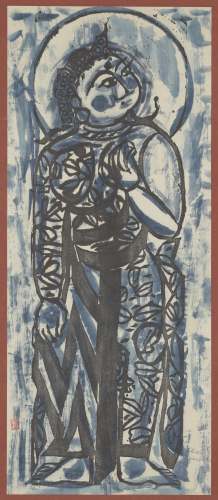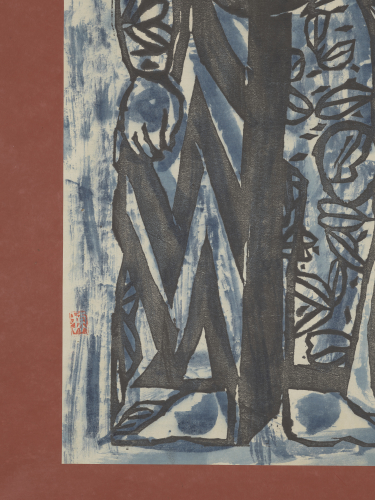Fugen bosatsu (Bodhisattva Samantabhadra), from the series Ni bosatsu Shaka jūdai deshi (Two Bodhisattvas and Ten Great Disciples of Shakyamuni)

Munakata Shikō, Fugen bosatsu (Bodhisattva Samantabhadra), from the series Ni bosatsu Shaka jūdai deshi (Two Bodhisattvas and Ten Great Disciples of Shakyamuni), 1948 (blocks); ca. 1955-1960 (impression), hanging scroll; monochrome woodblock print with hand coloring on reverse side of paper, Bequest of Margery Hoffman Smith, © unknown, research required, 83.38.322


This work is not currently on view.
- Title
Fugen bosatsu (Bodhisattva Samantabhadra), from the series Ni bosatsu Shaka jūdai deshi (Two Bodhisattvas and Ten Great Disciples of Shakyamuni)
- Related Titles
catalog entry: Bodhisattva Samantabhadra, from the series Ni bosatsu Shaka jû dai deshi (Two Bodhisattvas and Ten Great Disciples of Shakyamuni)
original language: 普賢菩薩像
series (original language): 二菩薩釈迦十大弟子
series (translated): Two Bodhisattvas and Ten Great Disciples of Shakyamuni
series (transliterated): Ni bosatsu Shaka jūdai deshi
translated: Bodhisattva Samantabhadra
transliterated: Fugen bosatsu zō
- Artist
- Date
1948 (blocks); ca. 1955-1960 (impression)
- Period
Japan: Shōwa period (1926-1989)
Japan: Shōwa period (1926-1989)
- Medium
hanging scroll; monochrome woodblock print with hand coloring on reverse side of paper
- Dimensions (H x W x D)
painting: 37 1/2 in x 15 3/4 in; mounting: 78 in x 23 1/2 in
- Inscriptions & Markings
artist's seal: 棟, stamped in red intaglio, lower left Transliteration: Mune Language: Japanese Description: The first character from the artist's personal name, Munakata
signature: Shiko Munakata, graphite, lower right Transliteration (Translation): Shiko Munakata (Shiko Munakata) Language: Japanese (Roman script)
- Collection Area
Asian Art; Graphic Arts
- Category
Prints
Japanese Modern Prints
- Object Type
relief print
hanging scroll
- Culture
Japanese
- Credit Line
Bequest of Margery Hoffman Smith
- Accession Number
83.38.322
- Copyright
© unknown, research required
- Terms
Munakata Shikō was born into an impoverished blacksmith's family in Aomori, in the far north of Japan. Unable to continue his formal education beyond elementary school, he taught himself to do woodblock printing. So nearsighted that he was nearly blind, Munakata worked by carving with his face right next to his blocks of plywood, chiseling away with furious energy.
Munakata's famous series, Two Bodhisattvas and Ten Disciples of the Buddha, was originally carved from twelve large blocks of katsura wood in 1939. The resulting prints were intended to be panels for a pair of six-fold screens. During the course of the Pacific War, Munakata used the large woodblocks to line the walls of the bomb shelter at his Tokyo home. The blocks for the outer panels—the figures of the bodhisattvas Manjusri and Samantabhadra—were destroyed. Munakata carved replacements in 1948. The reconstituted pair of screens, printed in monochrome ink, won prestigious prizes in international biennales in 1955 and 1956, skyrocketing Munakata to international fame. The image of Samantabhadra (Fugen Bosatsu) was meant for the far left panel of the right screen.
This print and its companion, 83.38.321 (Manjusri) in the Museum's collection were apparently never mounted on a screen but designed to be displayed as a pair of hanging scrolls. The color was applied by hand to the reverse of the paper and allowed to soak through.
- Exhibitions
2011 The Artist's Touch, The Craftsman's Hand: Three Centuries of Japanese Prints from the Portland Art Museum Portland Art Museum









